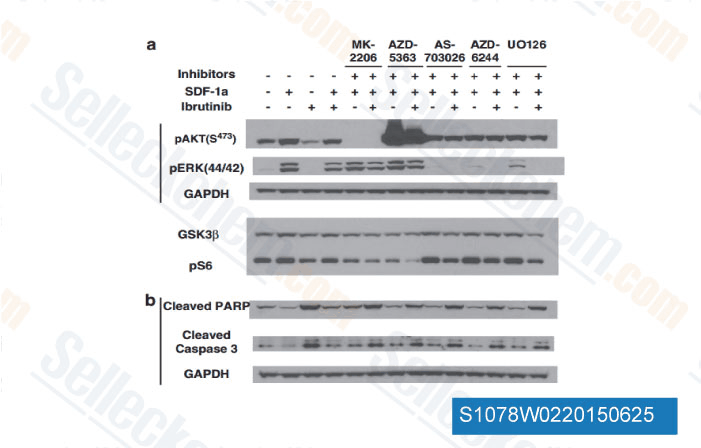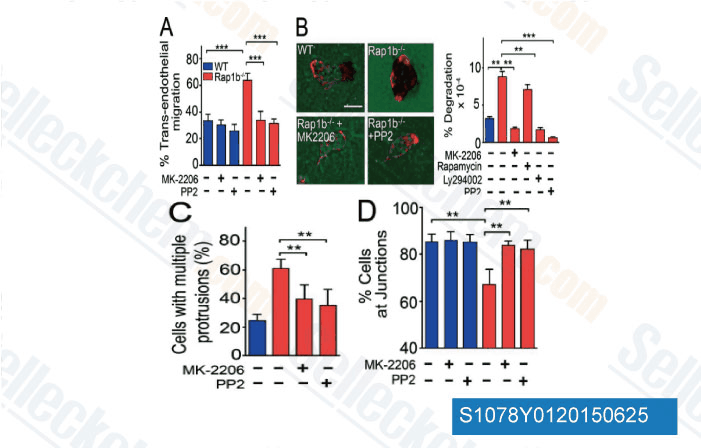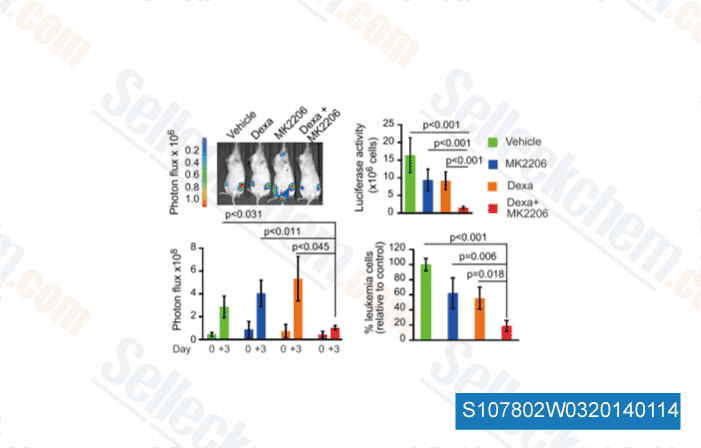|
Toll Free: (877) 796-6397 -- USA and Canada only -- |
Fax: +1-832-582-8590 Orders: +1-832-582-8158 |
Tech Support: +1-832-582-8158 Ext:3 Please provide your Order Number in the email. |
Technical Data
| Formula | C25H21N5O.2HCl |
||||||
| Molecular Weight | 480.39 | CAS No. | 1032350-13-2 | ||||
| Solubility (25°C)* | In vitro | DMSO | 25 mg/mL (52.04 mM) | ||||
| Water | 2 mg/mL (4.16 mM) | ||||||
| Ethanol | Insoluble | ||||||
| In vivo (Add solvents to the product individually and in order) |
|
||||||
|
* <1 mg/ml means slightly soluble or insoluble. * Please note that Selleck tests the solubility of all compounds in-house, and the actual solubility may differ slightly from published values. This is normal and is due to slight batch-to-batch variations. * Room temperature shipping (Stability testing shows this product can be shipped without any cooling measures.) |
|||||||
Preparing Stock Solutions
Biological Activity
| Description | MK-2206 2HCl is a highly selective inhibitor of Akt1/2/3 with IC50 of 8 nM/12 nM/65 nM in cell-free assays, respectively; no inhibitory activities against 250 other protein kinases observed. MK-2206 2HCl induces autophagy and apoptosis in cancer cells. Phase 2. | ||||||
|---|---|---|---|---|---|---|---|
| Targets |
|
||||||
| In vitro | MK-2206 is an allosteric inhibitor and is activated by the pleckstrin homology domain. MK-2206 inhibits auto-phosphorylation of both Akt T308 and S473. MK-2206 also prevents Akt-mediated phosphorylation of downstream signaling molecules, including TSC2, PRAS40 and ribosomal S6 proteins. [1] MK-2206 inhibits Ras wild-type (WT) cell lines (A431, HCC827, and NCI-H292) more potently when compared to Ras-mutant cell lines (NCI-H358, NCI-H23, NCI-H1299, and Calu-6). MK-2206 also shows synergistic responses in combination with cytotoxic agents such as erlotinib or lapatinib in lung NCI-H460 or ovarian A2780 tumor cells. [2] MK-2206 or siRNA-mediated Akt inhibition strongly activates autophagy in human glioma cells. However, eukaryotic elongation factor-2 (eEF-2) silencing suppresses MK-2206-induced-autophagy, with a promotion of apoptotic cell death. [3] | ||||||
| In vivo | MK-2206 shows 60% TGI and inhibits more than 70 % of phospho-Akt1/2 (T308 and S473) in A2780 ovarian cancer xenografts at a dose of 240 mg/kg. [1] MK-2206 exhibits significant antitumor activity in NCI-H292 xenograft in combination with erlotinib or lapatinib. [2] | ||||||
| Features | The first allosteric small molecule inhibitor of Akt to enter clinical development. |
Protocol (from reference)
| Kinase Assay: |
|
|---|---|
| Cell Assay: |
|
| Animal Study: |
|
References
Customer Product Validation

-
Data from [Data independently produced by Nat Commun, 2015, 6:6943]

-
Data from [Data independently produced by Leukemia, 2015, 29(1), 169-76]

-
Data from [Data independently produced by J Exp Med, 2014, 211(9), 1741-58]

-
Data from [Cancer Cell, 2013, 24, 766-76]
Selleck's MK-2206 2HCl has been cited by 2030 publications
| GRB2 stabilizes RAD51 at reversed replication forks suppressing genomic instability and innate immunity against cancer [ Nat Commun, 2024, 15(1):2132] | PubMed: 38459011 |
| Cancer cell genetics shaping of the tumor microenvironment reveals myeloid cell-centric exploitable vulnerabilities in hepatocellular carcinoma [ Nat Commun, 2024, 15(1):2581] | PubMed: 38519484 |
| Gadd45g insufficiency drives the pathogenesis of myeloproliferative neoplasms [ Nat Commun, 2024, 15(1):2989] | PubMed: 38582902 |
| Comprehensive multi-omics analysis reveals WEE1 as a synergistic lethal target with hyperthermia through CDK1 super-activation [ Nat Commun, 2024, 15(1):2089] | PubMed: 38453961 |
| AKT1 phosphorylation of cytoplasmic ME2 induces a metabolic switch to glycolysis for tumorigenesis [ Nat Commun, 2024, 15(1):686] | PubMed: 38263319 |
| PD-L1-expressing tumor-associated macrophages are immunostimulatory and associate with good clinical outcome in human breast cancer [ Cell Rep Med, 2024, 5(2):101420] | PubMed: 38382468 |
| UPP1 enhances bladder cancer progression and gemcitabine resistance through AKT [ Int J Biol Sci, 2024, 20(4):1389-1409] | PubMed: 38385072 |
| CUL4B mutations impair human cortical neurogenesis through PP2A-dependent inhibition of AKT and ERK [ Cell Death Dis, 2024, 15(2):121] | PubMed: 38331954 |
| Tumor suppressor let-7 acts as a key regulator for pluripotency gene expression in Muse cells [ Cell Mol Life Sci, 2024, 81(1):54] | PubMed: 38261036 |
| Hyperfunction of post-synaptic density protein 95 promotes seizure response in early-stage aβ pathology [ EMBO Rep, 2024, none] | PubMed: 38413732 |
RETURN POLICY
Selleck Chemical’s Unconditional Return Policy ensures a smooth online shopping experience for our customers. If you are in any way unsatisfied with your purchase, you may return any item(s) within 7 days of receiving it. In the event of product quality issues, either protocol related or product related problems, you may return any item(s) within 365 days from the original purchase date. Please follow the instructions below when returning products.
SHIPPING AND STORAGE
Selleck products are transported at room temperature. If you receive the product at room temperature, please rest assured, the Selleck Quality Inspection Department has conducted experiments to verify that the normal temperature placement of one month will not affect the biological activity of powder products. After collecting, please store the product according to the requirements described in the datasheet. Most Selleck products are stable under the recommended conditions.
NOT FOR HUMAN, VETERINARY DIAGNOSTIC OR THERAPEUTIC USE.
